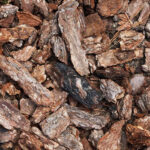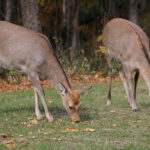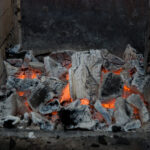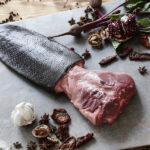If you are interested in diving into the world of more sustainably produced meats but aren’t sure what to expect, then you’ve come to the right place.
Bison and venison are two common types of game meat in North America and have a lot to offer for those interested in experimenting in the kitchen.
Venison and bison are both leaner, healthier alternatives to beef and are often hunted in the wild or raised on a grass-fed ranch, so their ecological impact is less than beef as well.
With all of that in mind, let’s take a closer look at comparing venison vs bison.
Table of Contents
Venison vs. Bison: Taste
Let’s start with perhaps the most important aspect of any meat: how they taste. If you’ve never had venison or bison, you might be surprised by the nuances of their flavors.
Flavor
Venison is super lean red meat. Since deer live in the wild, the flavor of the meat can vary considerably depending on the season, the recent diet of the animal, and the age of the deer.
Venison can taste pretty gamey, especially if it comes from a mature buck, and often has a bit of a metallic flavor to it. Venison is also often described as having earthy tones to it, reflecting the deer’s diet of browse, nuts, and grass.
A lot of the gamey or unpleasant flavors that people complain about in venison are the result of keeping too much fat in the meat.
Bison, on the other hand, is also lean red meat but tastes very different from venison. Bison tastes a lot like beef, but with a more delicate, slightly sweeter flavor.
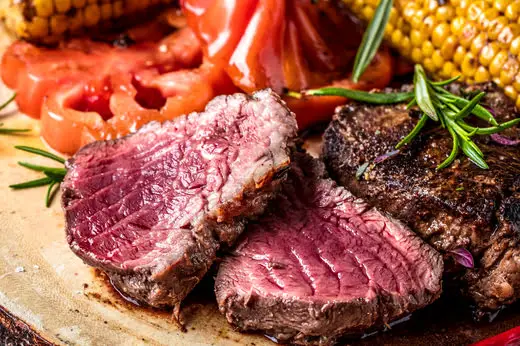
Bison meat has a lot less intramuscular fat than beef, but unlike venison, you don’t have to worry about discarding the fat that is there.
Consistency
Bison and venison are pretty similar in their texture and consistency. Since they are both super lean, they have a greater tendency to dry out than many other, fattier types of meat. Ultimately the texture will come down to how it is prepared.
Both venison and bison are very versatile meats, but the low-fat content means they both need to be prepared correctly to get the most out of the meat.
In both cases, you’ll want to either prepare them on high heat, as rare as you can tolerate, or low and slow in something like a braise.
You’ll want to avoid that medium to well-done level of cooking as the meat will become tough and not so pleasant to eat.
Venison vs Bison: Nutrition
Venison and bison are among the healthiest red meats, with lower fat and cholesterol than beef. Both types of meat are nutrient-dense and rich in vitamins and minerals. The table below gives a thorough comparison of venison vs. bison nutrition.
Data was gathered from the U.S. Department of Agriculture’s nutritional information for venison and bison. The exact nutrient content will vary depending on the cut of meat you are eating and how it is prepared.
The numbers provided are for 100 g (roughly 3.5 oz) of raw meat.
| Vitamin/Nutrient | Venison | Bison |
|---|---|---|
| Calories | 120 kcal | 119 kcal |
| Fat | 2.42 g | 3.15 g |
| Protein | 23 g | 21.1 g |
| Carbohydrates | 0 g | 0 g |
| Calcium | 5 mg | 5 mg |
| Iron | 3.4 mg | 2.88 mg |
| Magnesium | 23 mg | 24 mg |
| Phosphorus | 202 mg | 213 mg |
| Potassium | 318 mg | 353 mg |
| Copper | 0.25 mg | 0.202 mg |
| Sodium | 51 mg | 62 mg |
| Zinc | 2.09 mg | 5.27 mg |
| Manganese | 0.041 µg | 0.013 µg |
| Selenium | 9.7 µg | 28.7 µg |
| Vitamin C | 0 mg | 0 mg |
| Thiamin | 0.22 mg | 0.227 mg |
| Riboflavin | 0.48 mg | 0.347 mg |
| Niacin | 6.37 mg | 4.44 mg |
| Vitamin B-6 | 0.37 mg | 0.472 mg |
| Vitamin B-12 | 6.31 µg | 2.46 µg |
| Folate | 4.0 µg | 13 µg |
| Vitamin A | 0 µg | 0 µg |
| Vitamin E | 0.2 mg | 0.16 mg |
| Vitamin K | 1.1 µg | 1.1 µg |
Common Pairings and Uses
Venison and bison are both super versatile in how they can be prepared. Both types of meat are great for steaks, burgers, sausages, jerky, stews, braises, or any other method you can dream up.
Note that it is common to grind some pork or other source of fat in with your venison if you want to add some moisture to the resulting burger or sausage and change up the flavor a bit.
Venison Pairings
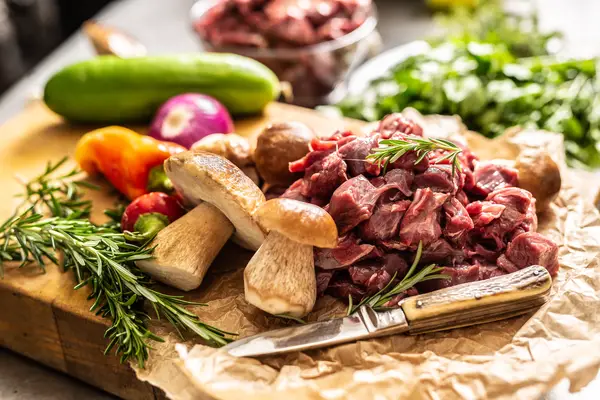
Perhaps because hunting season is usually in the fall, or perhaps due to the earthy tones in the meat, venison is commonly paired with autumnal flavors like squash, apple, pumpkin, and pear.
Venison works well with a wide variety of vegetables and flavor profiles, so don’t be afraid to experiment.
Some common flavor, herb, and spice pairings for venison include:
- Fruits: apple, cherry, blackberry, and quince
- Vegetables: potatoes, onions, and brussels sprouts
- Herbs: thyme, rosemary, bay leaves, sage
- Spices: black pepper, cloves, allspice, star anise, juniper
In addition to these pairings, venison can also go nicely with cheese!
Bison Pairings
Bison is also quite diverse in the flavors it pairs well with. You’ll have success pairing bison with any of the same flavors you love to use with beef.
Often bison is best left with simple seasonings to compliment the delicate flavor of the meat.
Some common flavor pairings with bison:
- Fruit: cranberry, saskatoon berry, currants
- Vegetables: potatoes, onion, garlic, asparagus
- Herbs: sage, basil, savory, oregano, rosemary
- Spices: Black pepper, paprika, chiles
Final Thoughts
Venison and bison are both lean, healthier red meat options than traditional options like beef, and both need to be prepared with care to avoid eating a tough, unpleasant steak.
Venison has a more unique taste with gamey, earthy tones, while bison tastes like a slightly sweeter, more delicate version of beef.
Hopefully, this article has given you the knowledge and confidence to experiment with venison or bison the next time you go to the market, or your neighbor brings home a buck.
Thank you for reading!

